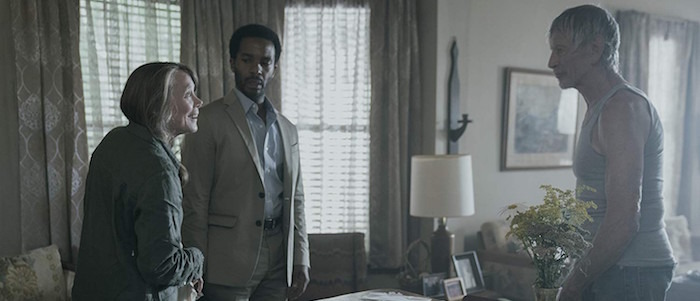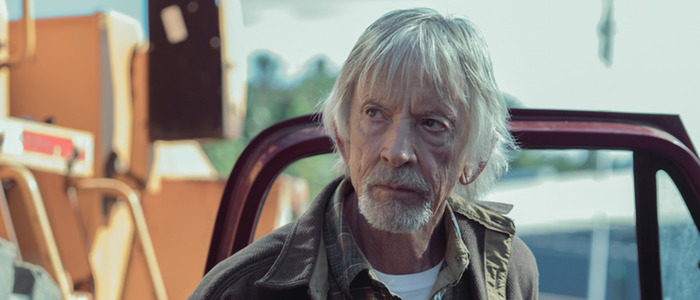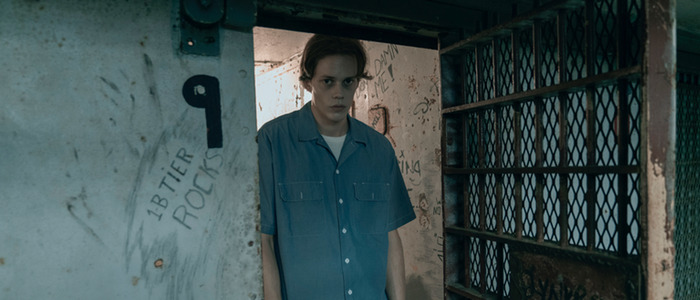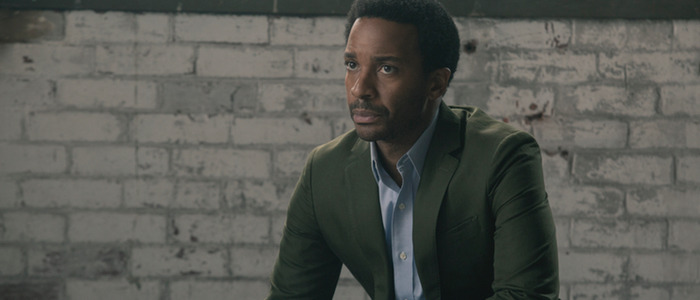All Things Serve The Beam: Could 'Castle Rock' Be Connected To 'The Dark Tower'?
"People think we're just one of those dead towns they heard about: a run of bad luck, worse judgement, broken promises. We know different, don't we? It's not luck. It's a plan...and not God's, either. Remember the dog? The Strangler? Sure, you do. How 'bout all the others that didn't make headlines?"
So goes Shawshank Prison Warden Dale Lacy's (Terry O'Quinn) voice over introduction to the second episode of Castle Rock (titled "Habeas Corpus"). But just what the hell is he even babbling on about in this string of vague references?
Like so many Stephen King-related tales, this may lead us to the Dark Tower. However, the road to get there is a bit long and winding, requiring us to explore the show's various references and Easter Eggs.
Major spoilers lie ahead.
Entry Level Easter Eggs
"The dog" is clearly Cujo – King's iconic rabid Saint Bernard – who was bitten by a rabid bat and then went on a kill-crazy rampage, trapping Donna and Tad Trenton in their Ford Pinto, after killing its abusive mechanic master, Joe Cambers, and his alcoholic next-door neighbor, Gary Pervier. During this bizarre standoff between beast and automobile at Cambers' garage (where the Pinto breaks down in Joe's dooryard), Cujo subsequently mauls Castle Rock Sheriff George Bannerman, before Donna drives the splintered handle of a broken baseball bat through the animal's skull.
As for "The Strangler", Frank Dodd was the son of Henrietta and Billy Dodd, and served as a deputy sheriff under Bannerman – as The Dead Zone was technically the first Castle Rock novel, published two years prior to Cujo. Frank was secretly responsible for several rape/murders of various women, and even assisted Bannerman in the investigation, successfully deterring the Castle Rock PD from ever suspecting him. It wouldn't be until Bannerman enlisted the aid of local psychic Johnny Smith to hunt the Strangler that Dodd was finally caught. Knowing the cops were closing in, Dodd slashed his own throat and hung a sign around his neck, lettered in lipstick: I CONFESS.
Strangely enough, there's been no mention of Thad Beaumont yet in Castle Rock; The Dark Half's reclusive author, whose pulp pseudonym George Stark began killing the folks responsible for his fictional death. Stark's murders were investigated by Bannerman's successor, Alan Pangborn, who'd taken over as Castle Rock's Sheriff. Though Thad resided in Ludlow, Pangborn inherited the case because a few of the brutal deaths fell under his jurisdiction. Pangborn would eventually come face-to-face with Stark's wrath, as Thad struggled to destroy his parasitic double.
Alan Pangborn and Needful Things
The Dark Half wouldn't be the last we'd hear from Sheriff Pangborn, as he was also the protagonist in King's "last Castle Rock novel", Needful Things. Published in 1991 – which, not coincidentally, is when Castle Rock's Henry Deaver (André Holland) went missing as a boy for eleven days in the woods before being discovered by Pangborn on Dark Score Lake – Needful Things was supposed to mark an end to the town's existence, as mysterious stranger Leland Gaunt (who could possibly be The Devil Himself) sets up shop in the middle of the sleepy Maine hamlet, with the titular store that sells anything the Rock's residents desire (at a rather costly spiritual price, of course).
However, Pangborn's inclusion in Castle Rock – where he's portrayed with sinewy charm by Scott Glenn – calls into question where the show falls on the timeline King laid out in the books. Constant Readers will recall that, during Needful Things' bombastic conclusion, the municipality is virtually destroyed thanks to the violence and bombings that Gaunt's presence stirs up. Utilizing sleight of hand he learned during his days studying to be a magician – something this iteration of Pangborn casually mentions at one point – Alan steals the valise that houses the souls of Gaunt's customers, just before the shopkeeper's vehicle transforms into a horse-drawn wagon and whisks the demon away into the darkness.
There's some lip service in the series paid to Castle Rock disincorporating, thus removing itself from the Maine map and causing many of the local businesses to exit the haunted hamlet. Thus begins struggling, psychic real estate agent Molly Strand's (Melanie Lynskey) quest to revitalize downtown, hoping to reattract commerce and inject new life into a failing Castle County. Yet this doesn't answer how enough of Castle Rock is left standing in the '91 prologue of this new series, as even the soaring aerial shots that open the pilot (titled "Severance") don't contain many traces of the mass destruction detailed in King's text.
27 Years
It's arguable that the most identifiable town King created isn't even Castle Rock anymore. Due to the '80s bestseller status, '90s television phenom, and now two-part aughts box office smash of IT, Derry may have overtaken the Rock as King's most recognizable Maine community (though this writer won't rest until Insomnia finally gets its proper due). However, this new series may change all that, as it possibly aligns the two invented New England abodes with a common thread: an ancient subterranean evil (played by the same actor, no less!).
Bill Skarsgård – who also threw on the grease paint as Pennywise the Clown (AKA Bob Gray) in Andy Muschietti's '17 take on IT – now has the market cornered on portraying all-knowing, virus-like evils in filmic King adaptations. In Castle Rock, Warden Lacy believes that Skarsgård's "The Kid" may be responsible for all the awful events that have plagued the town over the years. Once he's uncovered – in a secret cell buried beneath an abandoned Shawshank ward (that's been empty since a devastating fire in '87) – more awfulness transpires that nobody (especially his new Civil Rights attorney, Henry Deaver) seems equipped to stop. The star witness in the Kid's case – guard Dennis Zalewski (Noel Fisher), who's disgusted by the wanton brutality employed by the prison – goes on a shooting rampage after the convict seemingly infects his mind. After Warden Lacy's interim replacement (Ann Cusack) releases the boy following the ensuing PR nightmare, his mere presence causes an ostensibly happy man to murder his whole family.
Yet beyond the performer playing both roles, another element unifies "The Kid" with Pennywise the Dancing Clown: the interval in which they emerge from their lairs: 27 years. That's how long Pennywise hibernates before crawling back to the surface of Derry to feed on the fear and flesh of its children.
According to Alan Pangborn, the last time he saw the prisoner was in Lacy's trunk in '91, before the Shawshank honcho built the boy his very own bear cage in the penitentiary's lowest levels. It wouldn't be until 2018 that the Kid would rise from his depths, and seemingly not by accident. At the end of episode five ("Harvest") the prisoner says to Pangborn (at gunpoint, no less) "you have no idea what's happening", cryptically alluding to the notion that there's some sort of grand design at play. Whose plan is unfolding before our eyes in this ten-part piece of fan fiction? That has yet to be determined, Constant Readers, yet something tells me Lacy's right about one thing: it's certainly not God's.
Diane “Jackie” Torrance
In "Habeas Corpus", we're introduced to Jackie Torrance (Jane Levy) – a sexy, recovering addict and member of the local reverend's (Aaron Stanton) congregation – who takes an interest in Henry Deaver's return to town. Following a rather awkward first encounter at the Mellow Tiger (Castle County's busiest blue-collar pub), we later catch up with Torrance at Molly's loft office, as she acts as the real estate agent's assistant. However, community revitalization isn't her passion; penning its history is, and Jackie sees Henry as another Castle Rock enigma that she can explore, hopefully as a means to get the hell out of Dodge.
In "The Harvest", Jackie shares her true vocation, plus the origins of her name. Halfway through the episode, Jackie takes the Kid on a drive to smoke some pot – as Henry and Molly have set him up in the office space – and she reminiscences about the town's evil heyday: "This town is so blah. People bitch about the bad old days, when there were like serial killers and psychopathic dogs... but I would give my left tit to go back there," Jackie tells him, before delving into her own storied past. "I had this uncle though," she begins. "He was a writer too. One winter he just flipped his lid and tried to axe murder his wife and kids in a fancy ski resort. And my folks will never talk to me about it. So, I took his name...to piss them off. My real name's Diane."
Yep, her uncle is the murderous Jack Torrance from The Shining.
Beyond being a sort of forced instance of fan service – arguably the most egregious on the show thus far – this unifies the Stephen King universe in a way that it's only really been once before – the interconnecting Dark Tower novels. Diane Torrance is now the daughter of either Brett or Mike (Jack's brothers), unless Becky (Torrance's lone sister) is her mother and she maintained her maiden name (which honestly doesn't seem beyond this character's odd, Edgelord psychology). Yet Jackie's moniker also solidifies that novels outside the "Castle Rock canon" are being used as the basis for this new mystery box serial.
In turn, if all the Horror Master's works are fair game for pillaging or expanding upon, that opens up the door for the series' possible greatest connection...
The Dark Tower and the Voice of God
Episode six of Castle Rock ("Filter") sees Henry encountering two mysterious travelers – a deaf man named Odin Branch (CJ Jones) and his interpreter/protégé Willie (Rory Culkin) – who claim to have known Henry's deceased, pastor father. Odin insists that the church wasn't Henry's father's true sanctuary, but that the man instead often journeyed into the woods to hear what he described as "the voice of God". Odin's advanced degrees allow him to assign a more scientific name to the sound: schisma. Schisma is what he labels "nanoscale psychoacoustics", that can be heard more intensely depending on the geographic location of the individual. Depending on how loud the schisma is, the specific spot is operating closer in parallel to a companion version of itself. In layman's terms, it means that there are "other heres, other nows". "All possible pasts, and all possible presents," Odin continues, "schisma is the sound of these places trying to reconcile themselves."
This sort of scientific babble is going to be vaguely familiar for anyone who counts themselves as a fan of King's Dark Tower series, as the climax of its first entry (The Gunslinger) explains (via Walter, The Man in Black) Roland of Gilead's possibly unreachable eponymous goal. The Tower is the lynchpin of all realities – the center of all creation – supported by a series of Beams, which expand from its center like a bicycle wheel. In essence, were these beams to be destroyed, all realities would drain away into nothingness. There are forces on each beam – most represented by an animal (turtle, bear, etc.) – whose primary task is to keep the Tower from being toppled by the epic tale's nefarious big bad, the Crimson King (whom the Man in Black serves). Should these evil entities reach the Tower and scale it to the top, they could possibly remold all existence to their awful whims. Roland, and others like him, have appointed themselves peacekeepers in their realm, as his "ka" (or "destiny")leads him on a quest for the Tower.
In the world of The Dark Tower, the Crimson King (AKA Ram Abbalah) is described as "Gan's crazy side". Gan is essentially this universe's equivalent to God, and speaks to men through "can-calah" (or what we mortals simply refer to as "angels"). Just as they do in the Bible, these fantastical beings can become sirens for the devoted, granting them purpose and delivering missions from up above.
In Castle Rock, Lacy leaves Alan Pangborn a message following his suicide that asks who "the defenders" of the town are, believing that the former Sheriff (along with himself) could've been filling those roles for a generation. Now, it could be Henry and Molly's turn to stand up and fight the forces of darkness – especially if the Kid turns out to be another of the Crimson King's servants (or, perhaps, Ram Abbalah Himself). Odin built a machine, based on schematics drawn up by Henry's father, to drown out the "noise" of the world, and allow them to hear the "voice of God" clearly. By the climax of "Harvest", Henry finds himself in a portable sound proof chamber, immersing him in "total silence", and the "schisma". Could the points where schisma is heard the loudest be where our reality nearly touches Midworld, the parallel existence where much of Roland's quest transpires?
Since the inclusion of Jackie Torrance's backstory informed us that the Castle Rock universe is going to draw from textual sources beyond those where the stories are primarily set, it's safe to assume that the show could, in all possibility, be attempting to try and build off of King's grandest work, which was also woven through multiple unrelated pieces of fiction.
If this is true, then executive producer JJ Abrams and showrunners Sam Shaw and Dustin Thomason have attempted a rather brazenly ambitious endeavor (and the ultimate act of tribute to America's greatest modern horror author). Obviously, there's a chance that none of this theory is true, but the clues seem to be headed in a direction of metaphysical, existential fantasy storytelling the likes of which we don't ever get on television (or anywhere else, really).
Stay tuned, Constant Readers, for Castle Rock may have achieved something grandiose, and we just haven't realized it yet.





